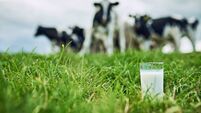Recent weather allows opportunity for liming
The recent spell of dry, but cool weather has opened a window of opportunity for farmers to spread lime, especially on drier silage ground.
Apply any lime required on the basis of a soil test now, while weather and where ground conditions allow.
A suggestion is to only half fill the lime spreader at any time, to avoid tracking fields.
Money spent on lime is one of the best investments a farmer can make on their farm.
Ground limestone can be spread at any time, with grass being grazed as soon as the lime has been washed off the leaves by rain.
However, lime is best spread in the autumn, while weather and ground conditions allow.
This will encourage growth in the coming spring by releasing organic nitrogen (N), phosphorous (P) and potassium (K) from the soil, encouraging earthworm and microbial activity, increased uptake and utilisation of chemical N, P & K fertiliser by grass plants and tillage crops.
Also, spreading lime in the autumn reduces the risk of lime being taken up in silage crops next year, and issues with the application of slurry or urea fertiliser.
Lime is the foundation of all soil fertility, grass growth and livestock production. Lime, along with P and K are essential grassland nutrients whose use has declined over the last decade. Ask most farmers when they last spread lime, and will they even remember? The low level of lime in the country, showing up in recent soil test results, will impact negatively on grass production in the coming years. Lime can have a huge effect on animal thrive, resulting in extra live weight gain and higher stocking rates. Lime supplies calcium, which is vital for healthy bone development in livestock, for milk production etc.
Lime is a soil conditioner, and improves sward quality. It is necessary to correct soil acidity and facilitate healthy plant growth. Soil acidity is measured on the pH scale of 0 to 14. The optimum pH for good grassland mineral soils is 6.3 to 6.5, and pH 5.5 to 5.8 for peaty soils.
Ryegrasses and clover perform best at these pHs or higher, but are replaced by lower productive grasses when the pH drops below pH 6.0. With 65% of soils in the country having a pH less than 6.3, keeping grassland mineral soils close to pH 6.3 is essential to maintain ryegrasses and clover content. Lime is critical at reseeding time to ensure good rye grass establishment. Liming promotes soil micro-organisms and encourages earthworm activity that breaks down plant and animal residues, to release plant nutrients, especially nitrogen. It is estimated that by liming an acid soil (pH 5.5), up to 64 units/acre of free nitrogen is released from the soil annually over several years.
At a time of high fertiliser prices, keeping soils at the recommended pH is a good investment. With lime, the correct pH allows optimum uptake and use of other nutrients such as P or K. Lime is the cement in the mix of N, P, K, and sulphur that makes them available to promote plant growth.
Lime is lost from the soil mainly in drainage water. This loss is from 250 to 500kg per hectare/year depending on the rainfall, soil type and the amount of lime in the soil at the start. Crops and livestock remove lime. An average crop of silage removes 60 to 80kg per hectare per year of limestone. Completing a soil test is the first step to take to correct any lime deficiency. Ideally, soil samples should be taken by a professional agriculturalist, or a person trained in taking samples. Follow carefully any recommendations of your Teagasc adviser or agricultural consultant.
When the pH of grassland soils are maintained close to the optimum range, increased grass production of at least one tonne of dry matter per hectare per year can be achieved. In addition to P and K release from the soil, N supply worth up to €50 per acre may also be achieved — thereby boosting the spring growth in particular. If this extra grass production is utilised by the grazing livestock, it has the potential to reduce farm feed bills by at least €181/ha/year. There is also the potential for reducing fertiliser costs in future years.
Leave at least three months between liming and silage harvesting. Leave three months between applying lime and following it with urea or slurry application. If reseeding, any lime recommended should be applied and tilled into the seedbed before any sowing commences.









